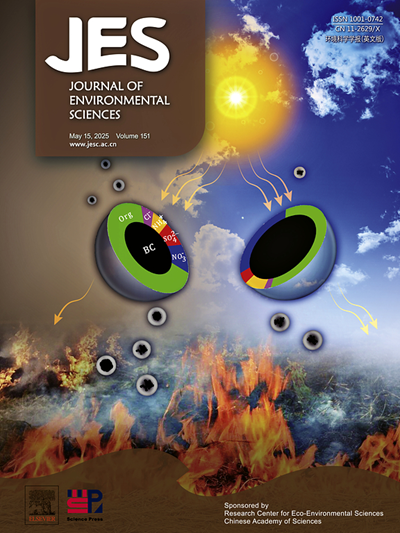Health effects of a glyphosate-based herbicide on Elliptio complanata: Multi-biomarker approach
IF 5.9
2区 环境科学与生态学
Q1 ENVIRONMENTAL SCIENCES
引用次数: 0
Abstract
The active ingredient (a.i.) glyphosate is frequently detected in waterways at relatively high concentrations, posing a risk to aquatic organisms including freshwater mussels, North America's most endangered animal group. This research aims to evaluate for the first time the effect of a glyphosate-based herbicide on a freshwater mussel (Unionid) using a battery of biomarkers. The mussel Elliptio complanata was exposed for 21 days to Credit® Xtreme (at 0, 50, 100, and 150 µg/L a.i. of glyphosate). An integrated biomarker response (IBRv2) was used to visualize the overall impact of each glyphosate-based herbicide concentration on mussels’ health conditions. The biomarker results showed that glyphosate (used at 100 µg/L and 150 µg/L) induced lipid peroxidation in the gills and digestive gland and inhibited acetylcholinesterase in the foot and gills, indicating oxidative damage and neurotoxicity. Other biomarkers were influenced at the lowest concentration of glyphosate tested (50 µg/L): lipids (decrease), triglycerides (increase) and, to a lesser extent, vitellogenin (decrease). For the latter biomarkers, the sexes were not affected similarly, and they were only sensitive at 50 µg/L, only females showed a trend toward a decrease for vitellogenin and a decrease for lipids. Using IBRv2, we found a clear discrimination between concentrations, and the index values increased with glyphosate concentration, attesting to the deterioration in biomarker-defined mussel health when exposed to Credit® Xtreme at realistic glyphosate concentrations in agricultural rivers. This study shows that glyphosate-based herbicides can alter neurological function, induce oxidative damage, and selectively modify the E. complanata metabolism at relatively low concentrations.

草甘膦除草剂对扁椭圆的健康影响:多生物标志物方法
在水道中经常检测到活性成分(a.i.)草甘膦的浓度相对较高,对包括淡水贻贝在内的水生生物构成威胁,淡水贻贝是北美最濒危的动物群体。本研究旨在利用一系列生物标志物首次评估草甘膦除草剂对淡水贻贝(Unionid)的影响。将贻贝(Elliptio planata)暴露于Credit®Xtreme中21天(草甘膦浓度分别为0、50、100和150µg/L)。综合生物标志物反应(IBRv2)用于可视化每种草甘膦除草剂浓度对贻贝健康状况的总体影响。生物标志物结果显示,草甘膦(100µg/L和150µg/L)诱导鳃和消化腺脂质过氧化,抑制足部和鳃乙酰胆碱酯酶,表明氧化损伤和神经毒性。在最低草甘膦浓度(50µg/L)下,其他生物标志物受到影响:脂质(降低)、甘油三酯(增加)和较小程度的卵黄蛋白原(降低)。对于后一种生物标志物,性别没有类似的影响,它们仅在50µg/L时敏感,只有女性表现出卵黄原蛋白和脂质降低的趋势。使用IBRv2,我们发现浓度之间存在明显的区别,指数值随着草甘膦浓度的增加而增加,证明当暴露于信贷®Xtreme时,生物标志物定义的贻贝健康在农业河流中以实际草甘膦浓度恶化。本研究表明,草甘膦除草剂在相对较低浓度下可以改变神经功能,诱导氧化损伤,并选择性地改变拟南芥的代谢。
本文章由计算机程序翻译,如有差异,请以英文原文为准。
求助全文
约1分钟内获得全文
求助全文
来源期刊

Journal of Environmental Sciences-china
环境科学-环境科学
CiteScore
13.70
自引率
0.00%
发文量
6354
审稿时长
2.6 months
期刊介绍:
The Journal of Environmental Sciences is an international journal started in 1989. The journal is devoted to publish original, peer-reviewed research papers on main aspects of environmental sciences, such as environmental chemistry, environmental biology, ecology, geosciences and environmental physics. Appropriate subjects include basic and applied research on atmospheric, terrestrial and aquatic environments, pollution control and abatement technology, conservation of natural resources, environmental health and toxicology. Announcements of international environmental science meetings and other recent information are also included.
 求助内容:
求助内容: 应助结果提醒方式:
应助结果提醒方式:


